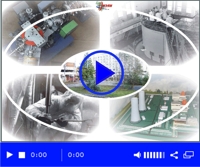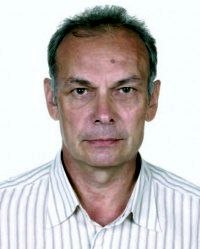Laboratory of Experimental Physics and Nuclear Safety of Reactor Facilities # 33
Mr. Svyatoslav SIKORIN
E-mail: sikorin@sosny.bas-net.by
Tel .: +375 (17) 373-48-14
+375 (17) 395-18-59
Fax: +375 (17) 374-83-35
History
:
This is one of the very first laboratories. It was created in 1962 on the initiative of the academician of the BSSR Academy of Sciences A.K. Krasin as part of the atomic energy department of the Institute of Heat and Mass Transfer of the BSSR Academy of Sciences in order to develop critical stands and conduct experimental research on them in the physics of nuclear reactors for various purposes and basing. When the Institute of Nuclear Energy of the Academy of Sciences of the BSSR was formed in 1965, the laboratory became a part of it. As a result of the reorganization of this institution in 1992, the laboratory became part of the Institute of Energy Problems of the NAS of Belarus. Since 2001 – as part of the State Scientific Institution «The Joint Institute for Power and Nuclear Research – Sosny» of the National Academy of Sciences of Belarus. The name of the laboratory has repeatedly changed, reorganizations have taken place, separate units were formed, but the main area of work has remained the same. Since 2007 – laboratory of experimental physics and nuclear safety of reactor facilities. From the moment of its formation and for a long time, the head of the laboratory was Ph.D., professor O. I. Yaroshevich. Now the laboratory is headed by S. N. Sikorin.
At present, the laboratory has critical stands “Hyacinth” and “Crystal”, as well as a set of hardware and software for conducting experimental studies in physics and safety in the development of nuclear reactors for various purposes and basing.
The main directions of scientific research:
:
- development of measurement techniques and calculations of the neutron-physical characteristics of nuclear reactors and critical assemblies;
- measurement and calculation of neutron-physical characteristics of nuclear reactors and critical assemblies;
- development and creation of hardware and software for monitoring and diagnostics of reactor facilities;
- development of promising nuclear reactors for various purposes;
- development of nuclear power plants for various purposes and basing;
- design, creation, operation and decommissioning of critical stands for various purposes;
- development, creation, operation and decommissioning of measuring instruments, devices and installations for experimental research at critical assemblies and nuclear reactors;
- design, operation and decommissioning of storage facilities for fissile materials and sources of ionizing radiation;
- the development of methods and the creation of hardware and software for non-destructive testing of the content of fissile and absorbing materials in fuel elements, fuel assemblies and other elements of the active zones of nuclear reactors;
- scientific and technical justification for the development of nuclear energy and the creation of a multifunctional research reactor in the Republic of Belarus;
- examination of project materials for reactor facilities and nuclear power plants in terms of nuclear and radiation safety, safety systems and process control;
- development and coordination with regulatory bodies of the Republic of Belarus of regulatory documents in the field of nuclear energy;
- development of scientific and technical ties with leading scientific nuclear centers of near and far abroad and more.
Over the past years, more than 100 uranium-containing critical assemblies with various material composition, structural diagram and purpose have been created and studied at critical laboratory stands of the laboratory, including:
- homogeneous heterogeneous uranium-water hexagonal and square lattices from cylindrical fuel rods of 10, 36 and 75% enrichment with a water reflector and absorbers in the form of cadmium wires and boron plates, as well as without absorbers;
- homogeneous heterogeneous uranium-water hexagonal lattices from hexagonal cassettes with cylindrical fuel rods of 21 and 36% enrichment with water, hydride zirconium, beryllium and steel reflectors, containing absorbers in the form of cadmium wires and boron plates, as well as without them;
- homogeneous heterogeneous uranium-polyethylene hexagonal lattices from cylindrical fuel elements of 75% enrichment with a polyethylene reflector;
- homogeneous heterogeneous uranium-water hexagonal lattices from cylindrical fuel elements of 75% enrichment with a water reflector;
- homogeneous heterogeneous uranium-water hexagonal gratings from cylindrical fuel rods of 75% enrichment with a central region in the form of a vortex chamber with ball fuel rods of small diameter 90% enrichment and a water reflector;
- homogeneous heterogeneous uranium hydride zirconium hexagonal lattices from hexagonal cassettes with cylindrical fuel rods 21 and 36% enrichment with hydride zirconium, beryllium and steel reflectors containing absorbers in the form of cadmium wires and boron plates, as well as without them;
- homogeneous heterogeneous uranium hydride zirconium hexagonal lattices from hexagonal cassettes with cylindrical fuel rods 21 and 36% enrichment with hydride zirconium, beryllium and steel reflectors containing absorbers in the form of cadmium wires and boron plates, as well as without them;
- heterogeneous heterogeneous multi-zone uranium-water and uranium hydride zirconium hexagonal lattices from hexagonal cassettes with cylindrical fuel rods of 21, 36 and 45% enrichment, boron absorbing plates, boron and europium absorbing rods, water, hydride zirconium, beryllium and steel reflectors;
- heterogeneous heterogeneous multi-zone fast-thermal uranium-containing breeding systems with a central zone without a moderator of cylindrical fuel rods with enrichment of 36 and 90%, a peripheral uranium-polyethylene square lattice of cylindrical fuel rods of 10% enrichment and a polyethylene reflector;
- homogeneous and heterogeneous heterogeneous single and multi-zone fast uranium-containing lattices from hexagonal cassettes without a moderator with cylindrical fuel rods 36 and 90% enrichment, boron absorbing rods, beryllium and steel reflectors
.
These experiments at critical assemblies were carried out to study the physics and safety of the reactors under development (various options for the active zones of the Pamir-630D mobile nuclear reactor, the fast-neutron reactor of the BRIG-300 experimental industrial nuclear power plant, a reactor with a fast-resonant neutron spectrum of PVER, etc. .). The developments were also used to test mathematical codes and nuclear data libraries used to calculate the developed reactor facilities.
After the Chernobyl accident, work was carried out to assess the nuclear safety of molten fuel-containing masses in the premises of the emergency power unit, as well as to determine the levels of radioactive contamination of the territory of Belarus and to control radioactive contamination of food products. In addition, the possibility of using underground nuclear power and heat supply nuclear power stations based on ship nuclear technologies to provide electricity and heat to facilities in various regions of the republic was also considered. Reactors with an active zone based on small-diameter ball fuel rods (microtuel rods) were studied. Work was carried out on the selection of a nuclear power plant project for construction in Belarus. Preparation and export to the Russian Federation of spent nuclear fuel from the IRT-M research reactor and the Pamir-630D mobile nuclear power plant were carried out. Studies are conducted to justify the development of a diagnostic complex of hardware and software for measuring the effects of reactivity and neutron noise diagnostics of the equipment of a nuclear power plant reactor. The possibility of building a new research reactor in the Republic of Belarus is being considered.








